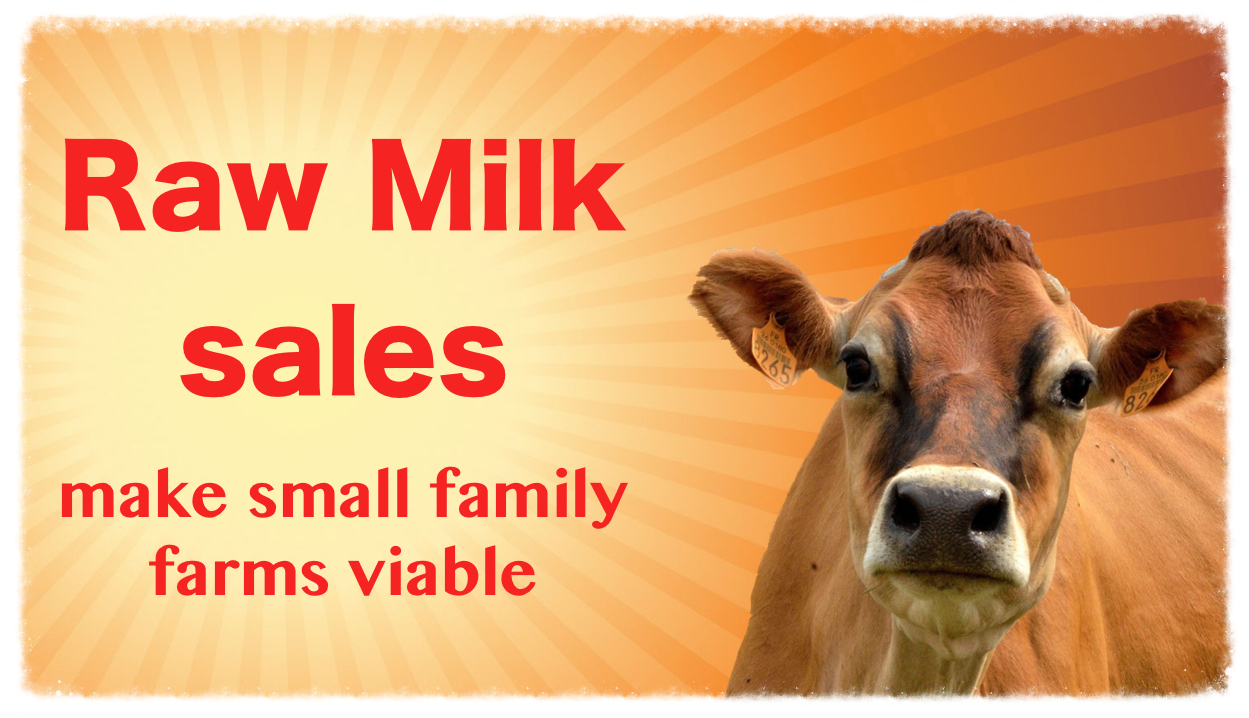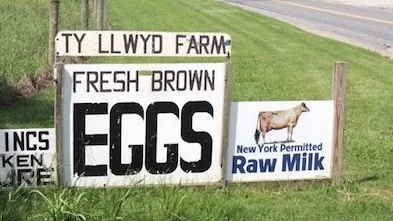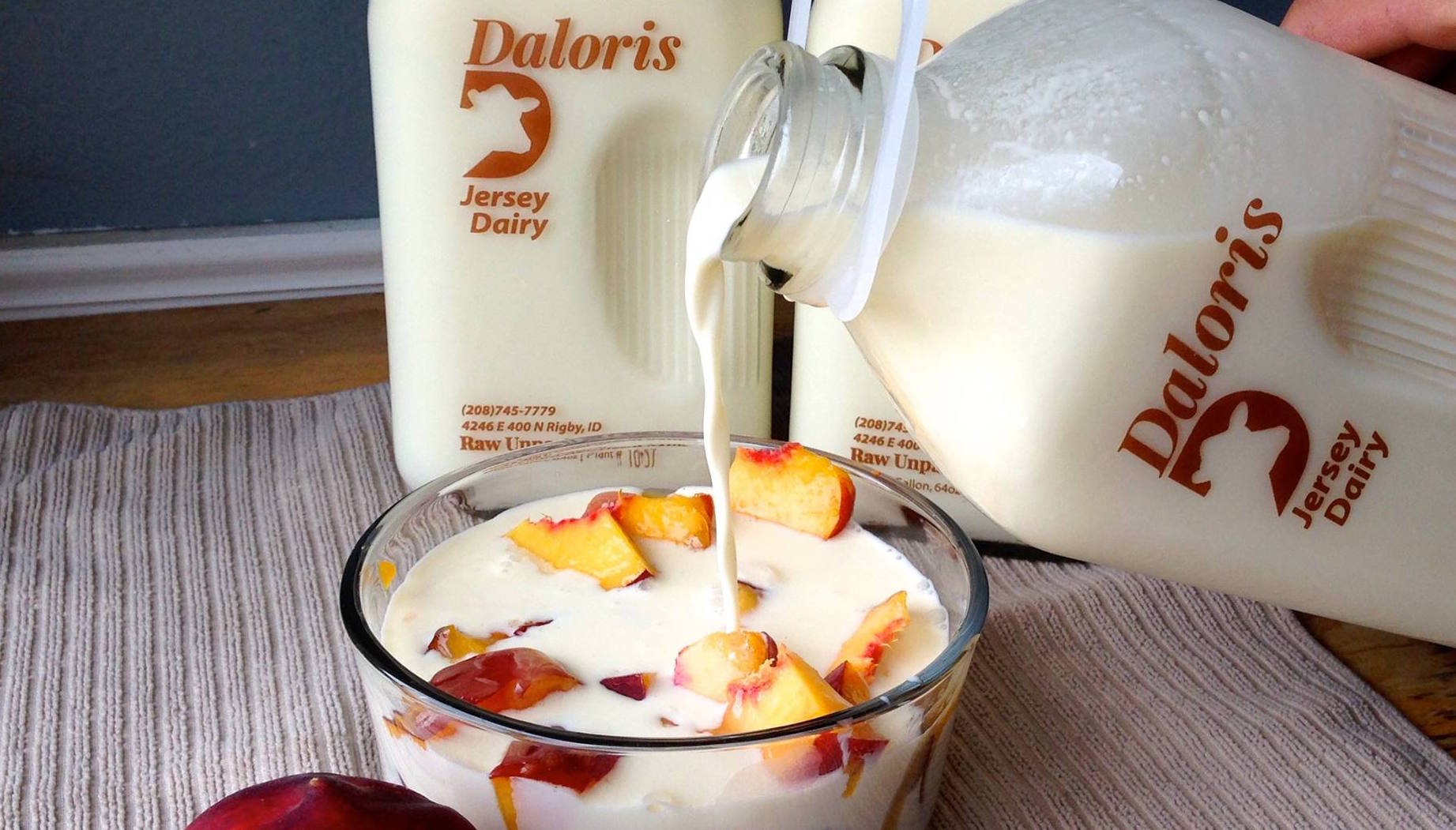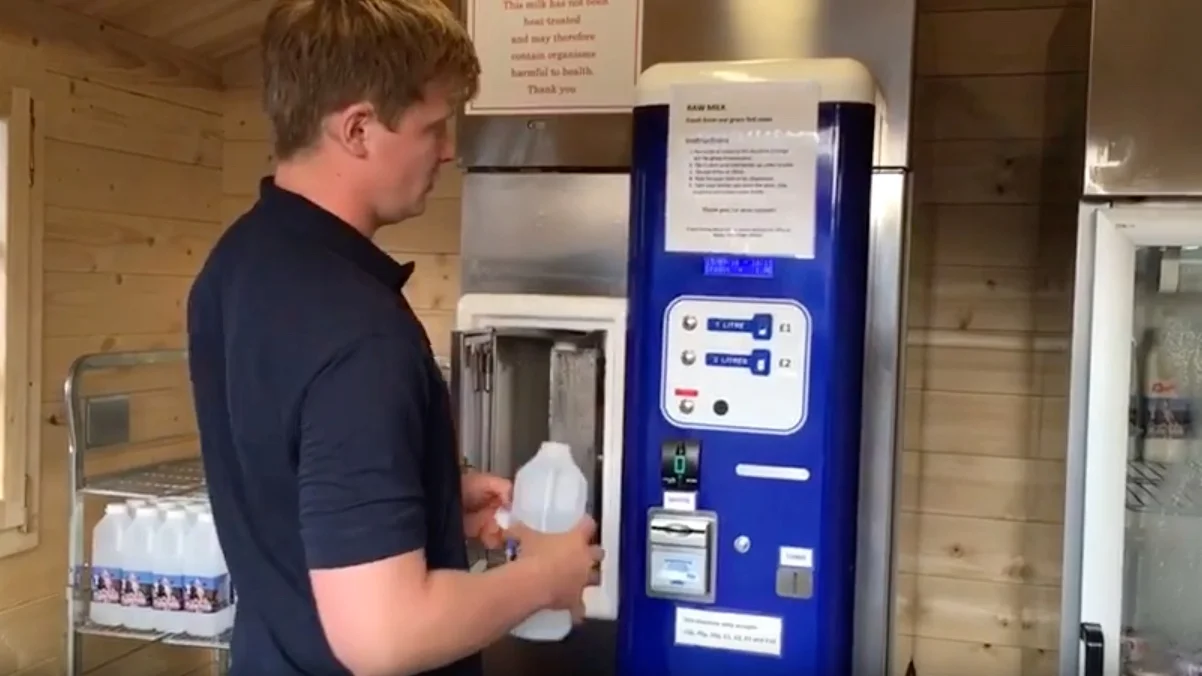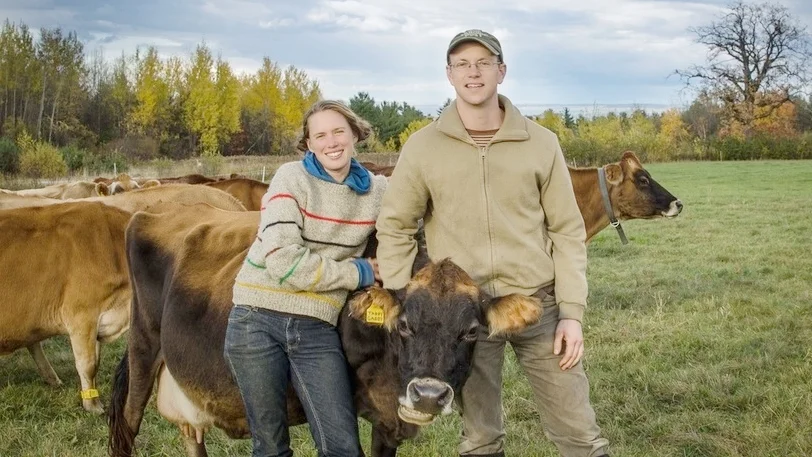Regulating Raw Milk in Australia
Making a case for regulated raw drinking milk
Countries like New Zealand, some USA states, England & Wales, Northern Ireland and many European countries have a regulated raw milk industry. According to this article, small business in the sectors of agriculture, forestry and fishing in Australia provide MORE THAN 80% of total employment. So why not change the overly strict, unfair regulations and allow small-scale farmers to produce artisan foods and expand on other high demand produce like raw milk and raw milk cheese? It will be really easy to create jobs in these high demand artisan food sectors.
Only 2 ‘countries’ have a blanket ban on raw cow's milk: Australia and Canada. Note that Scotland is not considered a ‘country’ by some. Raw goat's milk in Australia is regulated and legal to produce and sell for human consumption in 4 states. Australian regulations changed in 2015 to allow the production of raw milk cheese. In Scotland it is illegal to sell raw drinking milk, although raw milk cheese production and sales are legal. However, the Scots have been bringing in raw milk from across the border for many years, because there are technically no legal impediments. The courier service sales in England is seen as a direct farm-to-consumer sale, which is a requirement in England & Wales raw milk regulations. Raw milk for human consumption is technically ‘illegal’ in Canada unless you own the animal, but some communities enjoy access via herd shares ‘ownership’, and some routinely bring it in from the USA where it is available in 12 of the 13 bordering states.
Please help the Australian Raw Milk Movement lobby the government to get legislation in place for a regulated raw cow's milk industry in Australia. Some Australians can access ‘raw bath milk’ but since 2015 Victorians are unable to access any due to regulations that it require a bitter, gag inducing agent to discourage consumption.
Learn more about the fascinating details involved in each country:
Australia
Raw goat's milk is legal to produce and consume in four Australian states and is available from licensed producers. These are Queensland, New South Wales, South Australia and Western Australia.
Raw cheese production was legalised early 2015 in Australia. Landline story here. Cheesemaker Nick Haddow from Tasmania has now become a dairy farmer in order to produce his own high-quality raw milk for raw cheesemaking.
According to raw cheese advocate Will Studd, Australia didn’t introduce mandatory pasteurisation until 2001 - 2002 when the national food authority was formed that joined up all the states. He says there were some raw milk cheese produced in Australia in the 1980’s and even up until 2000.
Advocates of pasteurisation spin the myth that raw milk was phased out in the 1940s. In fact, raw milk remained legal until much more recently, as ‘town milk.’ In Victoria, it was available until 1990. In South Australia, the Tyler farm held a town milk licence until 2003 (source).
Tasmania had installed a regulated raw milk industry in 1971 (it’s uncertain which year it ceased).
Moo View Dairy in South Australia had been supplying raw cow's milk for up to 600 families for 17 years but was banned from supplying in July 2017. The Health Department claimed that in June there were higher than expected numbers of cryptosporidiosis (a form of gastroenteritis). According to Raw Milk Advocacy Association SA no trace of Cryptosporidium were found in the milk or on the farm, read more here.
The Country Women's Association Victoria requested “the State and Federal Governments to allow for the sale of raw milk for human consumption as long as it is from farms with quality control in place" (source)
Raw 'bath' milk was available in Victoria for around 10 years until it was required to contain a bittering agent from February 2015 to discourage human consumption. It was sold in small retail stores and at some farmers markets around Melbourne and country Victoria. Raw ‘bath’ milk have been available in some other Australian states for more than 15 years.
Swampy Marsh sold ‘bath milk’ around Victoria and Melbourne for 20 years, according to this news report. He no longer sells, due to Victorian regulation.
In December 2014 a few days after Christmas, then Minister of Consumer Affairs Jane Garrett announced new regulation requiring that raw milk sold in Victoria must contain a bitter, gag-inducing agent to discourage consumption.
Many raw milk supporters cannot consume pasteurised dairy anymore due to painful ear infections, gastrointestinal upset, allergy and asthma flare-ups. Some get anaphylactic reactions and risk death if they consume highly processed dairy products.
1 in 6 Australians are saying goodbye to (processed) dairy according to a June 2016 CSIRO study. Three-quarters of the study were eschewing dairy to relieve symptoms like bloating, stomach cramps and wind.
Australian children now have the highest rate of food allergy in the world according to this article.
Melbourne is now considered food allergy capital of the world according to researchers. Research shows a reduced risk of asthma, allergies, eczema, ear infections and colds in children that drink raw milk.
Melbourne is now considered the thunderstorm asthma capital of the world.
A new 2019 study found that taking antibiotics ‘triples risk of dying from flu – and can even make symptoms worse’. Signals from friendly gut bacteria keep antiviral genes in the lung lining active, helping maintain a first line of defence against flu. Antibiotics can wipe out early flu resistance - by wiping out the microbiome - and is hugely overprescribed in Australia.
The highest cancer rate for men and women together was in Australia, at 468.0 people per 100,000.
In 2008 Channel 9 produced this story about the benefits of raw milk.
Raw milk was blamed by the media for the death of a toddler on the Mornington Peninsula late 2014, read the Coroner's Findings here. Dairy farmer Vicki Jones said "we test it every week for bacteria, E. Coli and Listeria and the milk always comes back negative".
Also read this article about regulations in Australia and New Zealand: Fair Regulations and Production Standards for Raw Milk
Regulating raw milk enables the installation of a system that protects both consumers and producers. Not having a proper system sets dairy farmers up for failure and makes them targets of the system. See the following: Australian Dairy Farmer fined $50,000 and Moo View dairy banned.
The average age of the Australian farmer has been estimated at 57. Many raw milk producers overseas are millennials and ex-vegans. They understand the value and consumer demand for RDM.
Since 2000, Queensland has lost over 75% of its dairy farms, plummeting from 1500 to 360 in May 2019. 1 in 10 dairy farms in Victoria have closed in the last year since May 2019.
Australia is losing its family farms at an alarming rate, with our numbers down to 86,000 from 157,000 in 2011.
There is huge demand for ethical dairy food production system alternatives in Australia. How Now Dairy is a cow/calf friendly dairy that managed to crowdfund $500,000+ with 462 people in 31 days in 2019. Happy Cow Milk in New Zealand has been enjoying financial support from 600+ patrons via Patreon for the more ethical dairy model.
Australia used to have a number of diverse breeds producing milk, but some have been lost or face extinction due to industrialisation. About 70% Holstein now produce Australia’s milk.
The UK
The U.K.’s raw drinking milk systems was recently improved and training was given to dairy farmers.
Around 170 dairy farmers in England and Wales are registered to produce raw milk and other raw dairy products. Find them with Raw Milk Simkin.co.uk or the Food Safety Agency list.
The UK’s first on-farm raw milk vending machine went on exhibition in a museum in May 2019 and is called “Food, bigger than plate”. It was first installed in 2011 and the technology is now the new norm.
Hurdlebrook dairy in Somerset has been selling their raw milk for 20 years to the public, 15 of those years at London Farmers Markets. On the 8th of Augusts 2019, they tweeted that they had just finished their fist year of milking with 3 Lely Holding A4 robotic milkers, otherwise known as voluntary milking systems. More raw dairy producers overseas are cracking the code to successful robotic milking.
Hook and Son has been selling raw milk direct to the consumer since 2007 and now sell raw dairy at 20 farmers markets around London. Farmer Steve Hook say that demand jumped from 12 pints a week in 2007 to more than 5,000 in 2016. They have been selling raw milk online since 2010 and sales have increased five-fold with 3,000 pints ordered in a typical week. The milk sells for eight times the price of regular milk. According to a September 2017 story, Hook and Son is the largest licensed producer with a 80 dairy herd selling half a million pints of raw milk a year. Steve said he sells 10,000 pints a week and after 10 years there has not been a single incidence of food poisoning. According to this documentary they are Britain's largest raw milk producer.
Bunkers Hill Dairy won a dairy farmer of the year award for diversifying with raw milk from a vending machine. It is one of the many popular raw milk tourism hotspots.
Smiling Tree Farm micro dairy makes a fair living milking only seven Jersey cows.
The Calf at Foot dairy is a popular high animal welfare raw dairy.
Ahimsa milk (slaughter-free milk) is Britain's most expensive milk but very popular. There is a long waiting list.
Ethical milk alternatives have risen in popularity. The UK’s Cow Calf Dairies website now list more that 11 cow/calf friendly dairies, and more is underway.
The world’s first Ethical Farming Conference was held in May 2019 on a Scottish farm producing raw milk cheese. It was attended by 200 farmers, researchers, academics, students from Finland, Sweden, the Netherlands, Ireland, the USA and from the UK.
Evidence gathered in the UK show raw milk a low risk food.
The Royal family is known to consume raw milk for centuries. Queen Elisabeth is also known for drinking raw milk from her own herd.
By the twenties only 1.5 percent of Britain's milk was pasteurised. By 1939, most of it was still raw and it remained so in rural areas well into the fifties. In 2016 one in every 10,000 pints of milk sold in the UK is unpasteurised.
In 2015 the Irish government decided to engage with producers and create regulated sales of raw milk for Northern Ireland.
According to a 2018 FSA document, there has been a 5-fold increase in the volume of RDM production in the UK from around 610,000 litres in 2012 to 3.2 million litres in 2017.
According to a 2017 consumer survey finding, figure 12 showed most of the participants believed it is higher in nutritional content that conventional milk. Figure 20 showed that farmers markets and the farm gate were seen as the most suitable sales channels to consumers, followed by supermarkets.
According to this Northern Ireland article: "the proportion of the population currently consuming raw milk has increased from 3pc of the population in 2012, to 10pc of the population in 2018."
In Scotland it is illegal to sell raw drinking milk, although raw milk cheese production and sales are legal. However, the Scots have been bringing in raw milk from across the border for many years, because there are technically no legal impediments. The courier service sales in England is seen as a direct farm-to-consumer sale, which is a requirement in England & Wales regulations.
New Zealand
An estimated 100,000 New Zealanders drank raw milk each week.
According to information released to RNZ, at least 74 farmers were producing raw milk for sale in 2020, but just 23 have signed up to the four-year-old regulated system.
New Zealand introduced raw milk cheese production in 2009, according to Curd Nerd.
New Zealanders went to the farm gate and purchased raw milk for many years unregulated. New Raw Milk regulation came into effect in March 2016 and November 2016.
New raw milk dairies open in New Zealand to meet demand every few months despite very restrictive NZ regulations. The MPI website showed 27 raw drinking milk sellers registered in September 2018.
Many are very unhappy with NZ’s current RDM system from both sides of the debate. There is a very long list of complaints. Upon close inspection, it is not a fair system for many producers or consumers. Many farmers have closed down and are missing out on a niche market they can’t access. Illegal sales from unregistered producers, like ‘bath milk’ were also occurring, some fuelled by the frustration with MPI regulations. There has been an increase in unregistered sellers getting reported.
Over the years it has become clear that it is possible to produce low risk, pathogen-free RDM in a good system. RDM quality overall is only as good as the system that lays down the right controls, properly informs producers about risks, without imposing unnecessary restrictions. Many producers in the RDM system may be doing an excellent job, however, it is often those farmers who come from a large industrial dairy background, who may not be taking all the care required, because the system is not requiring it, or not specifying in sufficient detail. There are many aspects about the current system worth complaining about, some can be found here, and others can be discovered upon close investigation of the 11 categories of the Risk Identification and Risk Reduction Program.
Raw Drinking Milk regulations will be reviewed from November 2018. The review will determine whether changes need to be made to the system, and the results will be presented to Food Safety Minister Damien O'Connor mid 2019. The current system has potential pitfalls, and ARMM recommends MPI consult with the Raw Milk Institute. Once MPI has done this, the potential pitfalls in the system is likely to become very apparent.
MPI New Zealand currently considers the raw drinking milk its own system produces as high-risk. Many want to see the system change.
MPI’s raw milk information page makes drinking regulated raw milk sound like a risky pastime.
Between 2009 and 2016, there were 46 outbreaks of illness where consuming raw milk was a risk factor in New Zealand, however, that was before raw milk was regulated. If there is not a proper system to guide the responsible production of raw milk, there may be some incidence of illness in a population that is not used to that kind of (untested) product.
Food recalls of regulated raw milk can be found from 2016 onwards here. There has been six food recalls for raw milk so far in 2018.
The U.S.A.
The Raw Milk Institute (RAWMI) was founded in 2010 to develop and provide raw milk food safety standards, farmer education and farmer-to-farmer mentoring. Before that farmers lacked training and education, and had little guidance on how to produce the low risk raw milk consumers were looking for.
About 9.4 million Americans drink raw milk according to a 2007 CDC FoodNet survey, based on 2010 census data (source). This number will be much larger now because according to The Raw Milk Institute the raw milk renaissance took off in 2011.
Around 43 out of 50 USA states enable raw milk distribution and access (in some form) with New Jersey, Illinois and West Virginia being the latest. It’s challenging to keep up with latest developments in the US, so please see the Raw Milk Nation map.
To find raw milk producers in the USA, visit the Real Milk Finder US Listings and search per state.
11 USA states legalise the retail sale of raw milk. Some states like Washington allow retail sales of cow, goat and sheep milk.
Organic Pastures dairy in California has been selling their raw drinking milk directly to the consumer since 2000, now with a milking herd of 580 cows with a gross turnover of US$12 million. The business employ 105 people with 24 trucks going to more than 500 stores every week. They are also at 17 farmer's markets. See the product range here.
Organic Pastures dairy test twice a day using BAX PCR RT at a local laboratory and get results in 11 hours. They often get less than one on Coliforms, with zero pathogens, milking 580 cows, which is very impressive!
Organic Pastures dairy developed and implemented the first comprehensive Risk Analysis Management Plan (RAMP) in 2005 for the safe production of high-quality raw dairy. They continue to improve their food safety plan as better technology becomes available.
A large camel milk distribution company estimated that well over 10,000 autistic children in the USA were consuming raw camel milk.
Raw milk has never been illegal in California thanks the early form of the Mayo Clinic who produced certified raw milk and to the work of Alta Dena raw dairy and Organic Pastures raw dairy (more). Alta Dena served raw milk over a 40 year period (ending in 1999) and there wasn’t one epidemic, not one proved case of food-borne illness from it.
Other
The BC Fresh Milk Project (run by the BC Herdshare Association in Canada) shows “a statistically significant difference in coliform counts and standard plate counts between RAWMI-trained farmers and participants [Raw Milk Institute] who are either entirely untrained or are "in-training". For the purposes of this project, being "trained" is defined as regularly testing milk and meeting the bacterial targets set in RAWMI Common Standards, having had mentoring by a RAWMI-trainer, and having developed and implemented HACCP-based on-farm food safety plans (RAMP and SSOP) in accordance with RAWMI Common Standards.” Dr. Joanne Whitehead will be presenting results from the project at the International Milk Genomics Consortium conference in Aarhus, Denmark (12-14 Nov 2019).
Selling raw milk helps small farmers make a living.
Raw milk is a niche market for the small scale farmer in particular.
Only Australia, Scotland and Canada have a blanket ban on the raw drinking milk from cows. In Scotland people have been purchasing it online from England for many years. In Canada many herdshare arrangements provide milk despite being under prosecution. Raw milk for human consumption is technically ‘illegal’ in Canada unless you own the animal, but some communities enjoy access via herd shares ‘ownership’, and some routinely bring it in from the USA where it is available in 12 of the 13 bordering states.
Research into the human microbiome is booming. It is now certain that the human immune system lies in the gut. "These microbes influence the metabolism of foods, absorption of nutrients, production of hormones and neurotransmitters, and have a huge impact on the proper functioning of our immune system." (source).
If there is to be a recall of raw milk it is easier to manage in local communities. In January 2018 French dairy giant Lactalis were at the centre of an international salmonella scandal. 12 million boxes of powdered baby milk had to be withdrawn from supermarket shelves of 83 countries.
280 farmers across the Netherlands still make raw milk boerenkaas, or farmer’s cheese.
90% of Pakistan’s total milk consumption is raw unprocessed milk.
Australia is currently one of only two countries globally that prohibit the sale of raw cow's milk for human consumption.
All other countries allow raw milk to be supplied for human consumption, usually in conjunction with appropriate regulatory regimes that ensure the raw milk does not pose risks to the safety of those who choose to consume it. Such regulatory regimes have been introduced across Europe, many US states, and even in New Zealand, and have demonstrated that legislation governing the way cows are managed, and how raw milk is produced, packed, tested and transported can ensure a safe and raw product for consumers.
We believe that all Australians should have the choice to consume safe, unadulterated raw milk. We can access many raw foods, including raw meats, seafood, eggs and raw cheese. Raw cheese production was legalised in Australia early 2015. Even raw goat's milk is legal to produce in 4 Australian states and available from licensed producers. Yet raw cow's milk continues to be subject to prohibition, including through the 1 January 2015 introduction of regulations that it be tainted with a gagging agent to prevent human consumption.
Regulating the sale of safe raw milk will provide an effective avenue for small-scale farmers to access markets and sell their products directly to consumers. Please help us lobby the government for change.
Banning raw milk is unnecessary and unworkable, as consumers will continue to find ways to get it. History tells us that prohibition does not work.
More reasons to regulate raw milk in Australia:
Australia is blessed with conditions as good as any in the world for certified raw milk production.
Herds free of the major diseases of concern for human health.
Climate and soils allow grazing year round.
Education and infrastructure support services are world class.
Health conscious Victorians have much to gain from consuming raw milk when it is produced to the same demanding standards that apply in other countries.
Few foods support our immune system as well as raw milk does. Raw milk from healthy, grass-fed cows is a super-food, rich in nutrients and beneficial bacteria to keep out immune systems healthy and strong.
Raw milk is highly nutritious and has the potential to reduce illness and death from serious diseases—there is sound evidence that it protects against asthma, allergies, and respiratory infections, improves lactose tolerance, and is more easily digested by people with trouble digesting dietary fat. It is richer in available nutrients than pasteurised milk. Its vitamins have greater biological activity.
People should be free to consume the foods they believe are most healthy.
A profitable, well supported addition to the dairy industry is ready to flourish, but is blocked by current legislation
Support innovative dairy producers looking to diversify with safe, high quality products, instead of driving a product like raw milk onto the black market, where safety is less assured.
Banning raw milk is unnecessary and unworkable, as consumers will continue to find ways to get it. History tells us that prohibition does not work.
Get Involved: support legalisation of Raw Milk.
Australia's ban on raw milk is based on an incomplete risk assessment by Food Safety Standards Australia and New Zealand (FSANZ), which greatly exaggerated the risks to public health of raw milk.
Australia's ban on raw milk is based on an incomplete risk assessment by Food Safety Standards Australia and New Zealand (FSANZ), which greatly exaggerated the risks to public health of raw milk.
FSANZ's contention that raw milk is too dangerous to consume is not supported by evidence - where are the grave public health disasters in countries where raw milk is legal?
FSANZ is out of step with international experts in this area.
The New Zealand government was not persuaded by the advice of FSANZ and CSIRO on raw milk, and is expanding raw milk sales in line with world best practise.
New Zealand is moving ahead, assisted by the latest rapid on-farm milk testing technology. Its raw milk is safer than other ready-to-eat foods, and at least as safe as pasteurised milk.
Victoria is not bound to follow the Australian Food Code on raw milk. Its food choices are being decided on bad advice, based on unverified risk estimates.
Victoria is free to amend the Dairy Act, and if necessary the Food Act, to permit the sale of raw milk. Four states have already legalised raw goat's milk, using similar provisions.
There is considerable confusion about the risks posed by certified raw milk, compared with milk from dairy factories.
They are separate products. Neither is a threat to public health.
Milk produced to the highest standards of farming and hygiene is safe to drink in the raw form.
Certified raw milk reaches its consumers rapidly, often straight from the dairy. Properly refrigerated, it keeps for well over a week. There is no need for longer shelf life. Homogenisation is unwanted and unnecessary.
See the 11 risk categories of the Risk Identification and Risk Reduction Program to learn how risks can be identified and managed on the individual farm:
Videos: Raw Milk Producer, Mark Tyler from South Australia have been in courtrooms since 2013 over unpasteurised milk. Mark and raw milk producers Reg Matthews and Tyrone Brown advocate for a regulated raw milk industry that is in line with global best practise.
Audio: Interview with Reg Matthews - an organic dairy farmer from Western Victoria. Reg is currently an activist against the Raw Milk ban laws in Victoria. 29/05/2015
Audio: This interview is with Rebecca Freer from the Australian Raw Milk Movement. Rebecca has been a campaigner and activist against the Raw Milk ban laws in Victoria which has affected many organic dairy farmers and consumers.
Audio: The sale of raw milk has made headlines in South Australia, with one dairy farmer fighting in the courts to continue selling unpasteurised milk and recently winning a Supreme Court Appeal. 2 November 2015. The farmer at the middle of the controversy, Mark Tyler, joined Louise Pascale for a chat.






